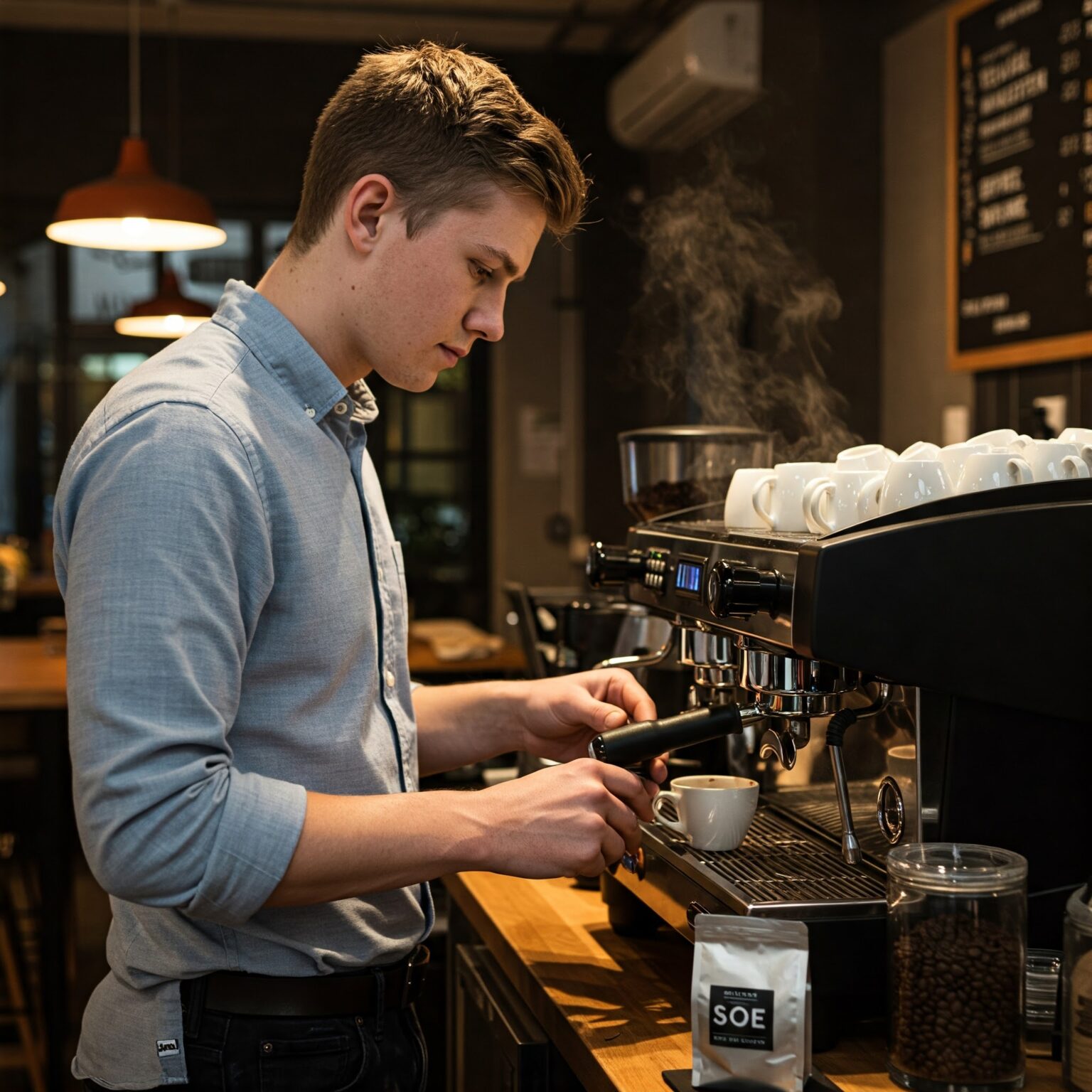Discover the Rich Flavor Profile of SOE Single Origin Espresso Today
Wiki Article
Comprehending Coffee Beans: the Journey From Coffee to Blended Coffee Beans

The Beginnings of Coffee: A Global Point Of View
While you could think about coffee as a modern staple, its beginnings map back centuries, linking with cultures around the world. The tale starts in Ethiopia, where legend claims a goat herder called Kaldi discovered the invigorating impacts of coffee beans after noticing his goats romping energetically after consuming them. This triggered rate of interest, causing coffee's infect Arab traders that cherished the made drink. By the 15th century, it got to Persia, Egypt, and Turkey, where coffee shops ended up being social hubs for discussion and culture.As trade routes expanded, coffee made its means to Europe in the 17th century, promptly acquiring appeal. Each society included its unique twist to coffee preparation, improving its history.
Cultivation and Harvesting of Espresso Beans
As coffee's trip developed, the focus moved to the growing and harvesting of certain bean selections, specifically those made use of for coffee. You'll find that espresso beans typically originate from Arabica or Robusta plants, each offering unique flavors. The suitable expanding problems consist of high elevations and abundant, well-drained soil, which improve the beans' quality.Throughout the harvest, selecting techniques vary. In some regions, workers hand-pick ripe cherries, guaranteeing only the most effective fruit goes to handling. In various other locations, mechanical harvesters are used, particularly on larger farms. When the cherries get to peak ripeness for optimum taste., timing is important; you want to gather.
Once collected, the beans are planned for processing, which is crucial in establishing their final preference. Comprehending the cultivation and collecting procedures offers you understanding into what enters into your preferred espresso, improving your admiration for each cup.
Processing Techniques: From Cherry to Bean
Since you have actually found out about harvesting coffee beans, let's discover exactly how those cherries change into the coffee beans you like. You'll see just how different harvesting strategies effect taste, adhered to by the crucial steps of fermentation and drying out. Finally, we'll damage down the milling and grading procedure that identifies your coffee's quality.Harvesting Strategies Described
When it pertains to coffee, recognizing harvesting techniques is crucial, because they straight impact the flavor and high quality of the beans you take pleasure in. There are two main methods: careful selecting and strip selecting. Selective picking involves hand-picking just ripe cherries, guaranteeing you get the most effective top quality beans. This approach commonly leads to a richer flavor profile, though it's more labor-intensive. On the various other hand, strip selecting methods collecting all cherries simultaneously, no matter ripeness. While it's quicker and more affordable, this can cause a mix of tastes, affecting the end product. Eventually, the option of gathering strategy can substantially influence your coffee experience, so it deserves knowing how those beans made it to your cup.Fermentation and Drying Out
After collecting, the following actions in handling coffee beans play a significant duty fit their taste. You'll locate that fermentation is vital, as it helps damage down the mucilage bordering the beans, improving their taste profile. Depending on the method, this procedure can last from a few hours to several days, with differing outcomes based on temperature level and humidity.Sun-drying enables the beans to soak up flavors from the environment, while mechanical drying guarantees constant moisture degrees regardless of weather condition. Correct drying is essential to protect against mold and protect the beans' quality, eventually affecting your mug of coffee.
Milling and Grading Refine
As fermentation and drying established the stage for flavor growth, the milling and grading process warranties that only the best coffee beans make it to your mug. This stage involves eliminating the outer layers of the coffee cherry, including the parchment and husk. After milling, the beans are sorted by size and weight, making sure an uniform top quality. You'll find that grading assists recognize issues and classify beans, which influences flavor and scent. High-quality beans obtain a higher quality, causing a richer coffee experience. Once graded, the beans are all set for product packaging and shipping, protecting their unique characteristics. This thorough process is crucial for providing the remarkable taste you appreciate in every sip of your favorite mixture.Toasting Strategies: Opening Taste Possible
When you roast coffee beans, the approach you pick can significantly affect the taste profile. Comprehending the connection between time, temperature, and toasting strategies is vital to disclosing the possibility of your mixture. Allow's check out just how these aspects come with each other to produce the ideal cup.Roasting Methods Discussed
While you may assume that all coffee toasting approaches generate the very same outcomes, the reality is that each technique discloses distinct taste capacities in the beans. Drum toasting uses a rotating drum to equally distribute warm, enhancing caramelization and creating a well balanced flavor. Air roasting, on the other hand, flows hot air around the beans, advertising a lighter roast with pronounced acidity.
Effect on Taste Profile
Various toasting techniques not just influence the procedure yet also substantially affect the taste profile of the coffee beans. When you select a light roast, you'll experience intense acidity and floral notes, showcasing the bean's beginning. On the other hand, a medium roast equilibriums acidity with sweetness, usually revealing chocolatey touches. Dark roasts, on the other hand, bring out bold, great smoky flavors, sometimes masking the bean's unique features. Each method reveals different oils and compounds, causing a vast range of flavors. By explore different roasting designs, you can discover which accounts reverberate with your palate. Understanding these subtleties aids you value the virtuosity behind your cup of coffee, enhancing your total experience with every sip.Time and Temperature Level Factors
To release the full taste possibility of coffee beans, both time and temperature level throughout the roasting process play considerable functions. When roasting, you'll find that greater temperature levels can swiftly establish flavors, but if you hurry it, you could wind up with charred notes. Conversely, lower temperatures permit for an extra progressive flavor development, showcasing the beans' one-of-a-kind features.
Timing is equally as vital; prolonging the roast also long can cause a loss of acidity and illumination, while too brief a roast may leave the beans underdeveloped. Locating that wonderful spot needs practice and testing. By adjusting these aspects, you can disclose the abundant, complex tastes hidden within each bean, producing a really remarkable coffee experience.
The Art of Mixing: Crafting Unique Coffee Profiles

Begin by choosing a base coffee that provides a solid structure. An intense Ethiopian bean can bring fruitiness, while an abundant Brazilian coffee includes body.
As you mix, maintain in mind that each mix narrates. You're not simply making coffee; you're developing an experience. Take your time, taste frequently, and delight in the journey of discovering your trademark mix - Single Origin Espresso.
Developing Approaches: Just How Prep Work Influences Taste
Mixing coffee opens up a domain name of flavor opportunities, however how SOE you make that blend can considerably affect your final cup. On the other hand, a pour-over highlights the coffee's clearness and illumination, best for showcasing delicate notes.Coffee, with its high pressure, produces a focused shot that accentuates sweetness and crema. If you prefer a lighter mixture, take into consideration a chilly mixture approach; it generates a smooth, less acidic preference.
Inevitably, experimentation is crucial. Adjusting variables like water temperature level, grind dimension, and brew time can change your coffee's account. Welcome the art of brewing to find the tastes hidden in your coffee blends. The right approach can elevate your experience to new elevations.
The Future of Coffee: Sustainability and Technology
As the coffee industry progresses, sustainability and innovation are ending up being essential for attending to ecological challenges and meeting customer needs. You'll notice that more coffee firms are adopting environment-friendly methods, from sourcing beans morally to executing sustainable farming strategies. These changes not just help the planet however additionally enhance the quality of the coffee you take pleasure in.You could see innovations like biodegradable packaging and water-saving developing techniques that minimize waste. Advanced technology, such as blockchain, is additionally ending up being popular, making sure openness in the supply chain, which permits you to map your coffee back to its origins.
In enhancement, purchasing local communities and supporting farmers through reasonable trade efforts cultivates an extra lasting coffee ecological community. As you drink your following cup, keep in mind that your options can add to a brighter future for coffee. By going with sustainable brands, you're not just taking pleasure in a beverage; you're making a positive effect on the globe.
Regularly Asked Inquiries
What Is the Distinction Between Arabica and Robusta Beans?
Arabica beans are smoother, sweeter, and have a higher acidity, while robusta beans are stronger, extra bitter, and consist of even more high levels of caffeine. You'll observe these differences in taste and scent when brewing your coffee.Just How Does Elevation Affect Coffee Bean Flavor?
Elevation effects coffee bean flavor considerably. Greater altitudes produce beans with brighter level of acidity and complicated tastes, while lower elevations usually yield beans that are larger and less nuanced. You'll see these differences in your mug!What Are the Health And Wellness Benefits of Alcohol Consumption Coffee?
Drinking coffee can boost your power, improve psychological emphasis, and even boost physical performance. It's abundant in antioxidants, might reduce the threat of certain illness, and can promote a healthier metabolic rate when consumed in small amounts.Can Coffee Beans Be Reused for Developing?
Yes, you can reuse coffee beans for brewing, yet the flavor could be weaker. If you take pleasure in trying out, try recycling them in different means, like cold brews or including to shakes for an extra kick.Just how Should I Store Coffee Beans for Freshness?
To keep your coffee beans fresh, save them in an airtight container in a trendy, dark place. Avoid subjecting them to warmth, wetness, or light, as these factors can swiftly weaken their taste and aroma.Recognizing Coffee Beans: the Journey From Espresso to Blended Coffee Beans.
Now that you've found out about gathering espresso beans, let's check out exactly how those cherries change right into the coffee beans you enjoy.When you roast coffee beans, the approach you pick can considerably influence the taste account - Single Origin Espresso.While you could assume that all coffee toasting methods yield the same outcomes, the reality is that each method reveals unique taste capacities in the beans.Different roasting methods not only influence the process however likewise considerably influence the taste account of the coffee beans
Report this wiki page